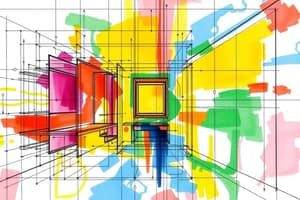Podcast
Questions and Answers
Which of the following is the correct arrangement of orthographic views (Top, Front, Side) derived using first angle projection?
Which of the following is the correct arrangement of orthographic views (Top, Front, Side) derived using first angle projection?
- Top view above the Front view, Side view to the left of the Front view.
- Top view below the Front view, Side view to the right of the Front view.
- Top view above the Front view, Side view to the right of the Front view. (correct)
- Top view below the Front view, Side view to the left of the Front view.
A solid object with a cylindrical hole is represented in orthographic projection. How will the hole typically be represented in the views where it appears as a circle?
A solid object with a cylindrical hole is represented in orthographic projection. How will the hole typically be represented in the views where it appears as a circle?
- As a dashed circle only.
- As a visible circle with a center mark. (correct)
- As a visible circle with a dashed circle inside it.
- As a visible circle only.
When creating orthographic projections, which of the following is NOT generally a consideration when deciding which face of the object should be the 'front' view?
When creating orthographic projections, which of the following is NOT generally a consideration when deciding which face of the object should be the 'front' view?
- The overall shape and how well it represents the object.
- The orientation of the object relative to the light source in the room. (correct)
- The complexity of the features visible in the view.
- The need to minimize hidden lines in the view.
In an orthographic projection, a line appears shorter than its true length. What can be concluded about the orientation of the line?
In an orthographic projection, a line appears shorter than its true length. What can be concluded about the orientation of the line?
You've created three orthographic views (Top, Front, Side) using first angle projection, but a client is accustomed to third angle projection. Which adjustment would correctly re-orient the views?
You've created three orthographic views (Top, Front, Side) using first angle projection, but a client is accustomed to third angle projection. Which adjustment would correctly re-orient the views?
Flashcards
Pictorial Representation
Pictorial Representation
A visual depiction showing length, height, and depth.
Freehand Drawing
Freehand Drawing
Creating a drawing by hand, without using tools or rulers.
Orthographic Projection
Orthographic Projection
Representing a 3D object using 2D views (front, top, side).
First Angle Projection
First Angle Projection
Signup and view all the flashcards
Three Views
Three Views
Signup and view all the flashcards
Study Notes
- A pictorial representation of a solid object is provided.
- The task is to draw by hand three views (first angle orthographic projection) of the given object.
Studying That Suits You
Use AI to generate personalized quizzes and flashcards to suit your learning preferences.




